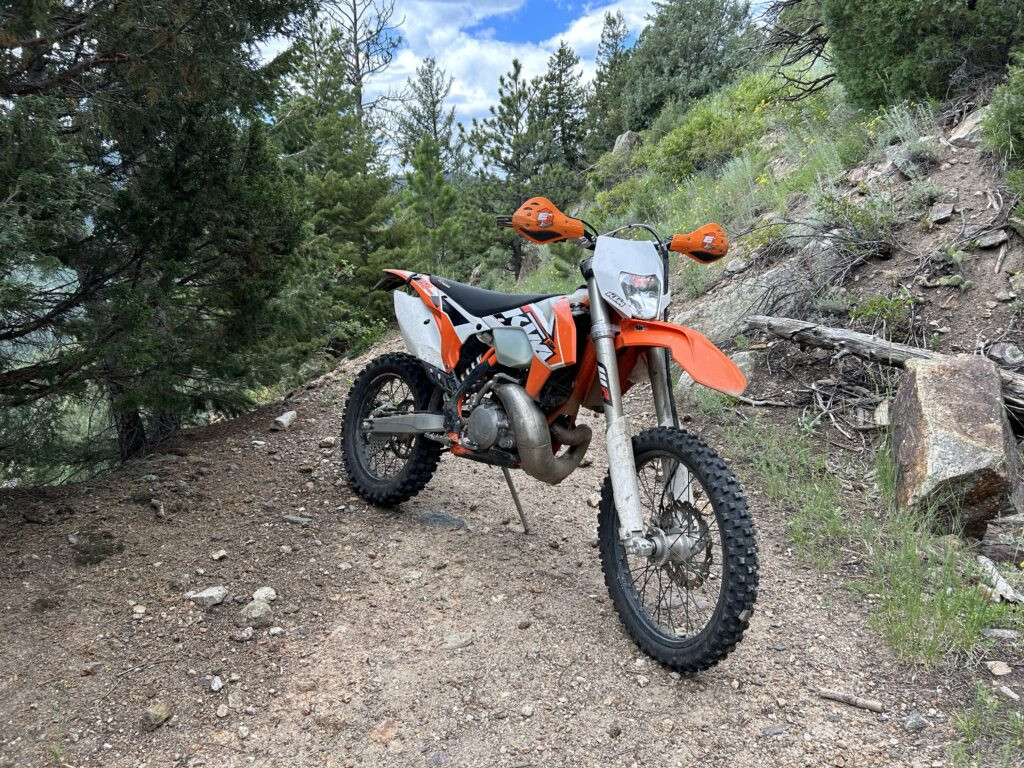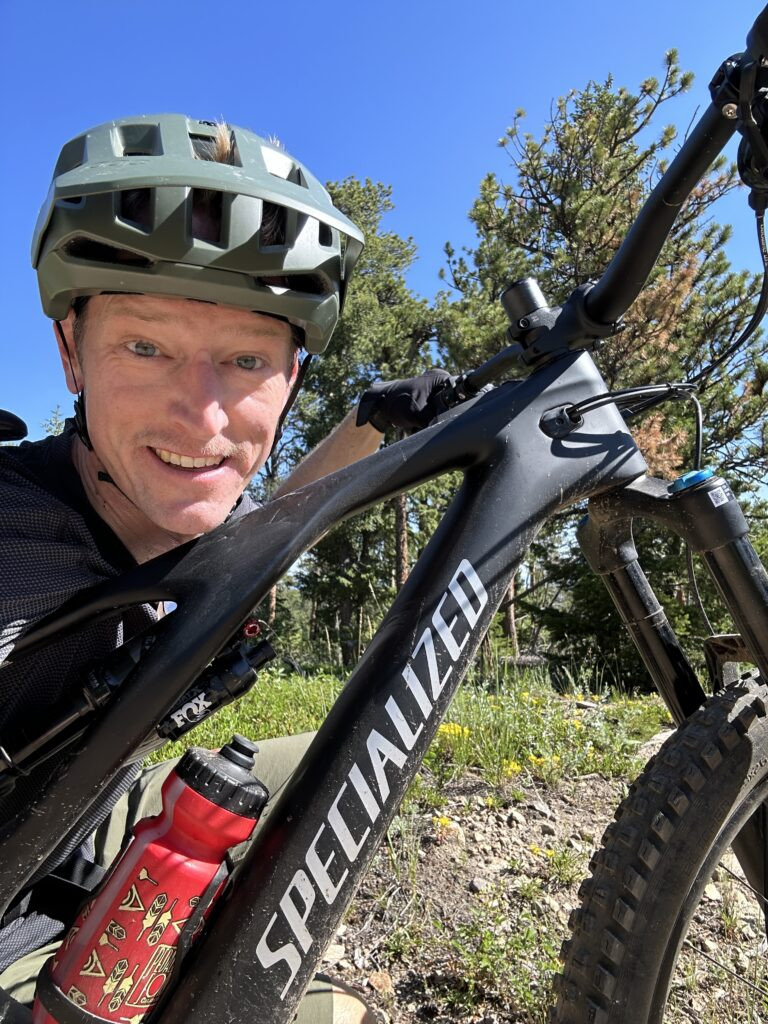Horsepower. The term itself conjures images of raw power, a relic from the Industrial Revolution, yet still used to quantify the might of modern machines. It’s a unit born from comparing steam engines to draft horses, equating one horsepower to 745.7 watts. This historical tidbit highlights the absurdity of dismissing an e-MTB as “just a dirt bike.” The two are worlds apart, so different they don’t even speak the same language of power measurement.
But instead of brushing off this simplistic comparison, let’s tackle it head-on. Having spent four years immersed in the dirt bike world and even longer on bicycles, I feel well-equipped to offer a real-world comparison between off-road motorcycles and electric mountain bikes. To put this to the test, I designed a track on trails suitable for both, essentially racing against myself to uncover the truth.
Dirt Bike vs. E-MTB: The Numbers Don’t Lie
It almost feels silly to even dignify the dirt bike versus e-MTB comparison with serious analysis. However, before diving into the actual riding experience, let’s lay bare the fundamental differences with some hard data.
| 2015 KTM 250 XCW | Specialized Turbo Levo Comp Carbon |
|---|---|
| Approx. Motor Output | 50 horsepower |
| Top Motorized Speed | 70mph |
| Suspension Travel | 292mm front, 317mm rear |
| Wheelbase | 1495mm |
| Approx. Weight | 250lbs |
| Approx Price | $6,000 used |
The table paints a clear picture: a dirt bike is bigger, faster, heavier, and significantly more powerful than an e-MTB. This shouldn’t come as a shock to anyone familiar with either type of machine. But the numbers alone don’t tell the whole story of how these vehicles perform on the trail.
Putting Them to the Test: The Race Against Myself
To move beyond simple specs and explore the real-world differences, I crafted a six-mile loop with 1,200 feet of elevation gain. This route, a mix of flowing singletrack, steep climbs and descents, and a section of fire road, was designed to challenge both a Dirt Bike And an e-MTB, particularly testing the e-bike’s battery range.
My first run was on my KTM 250 XCW dirt bike. While I have solid experience, I’d categorize my skills as intermediate, and my riding style leans towards controlled rather than aggressive. As a friend’s sticker aptly says, “Try Not To Crash,” which sums up my moto approach. I aimed for a smooth, consistent pace, but even with that, I made a couple of errors on steep uphill sections, requiring frustrating turnarounds. These mistakes highlighted a key difference: the sheer weight of a dirt bike. At 250 pounds, maneuvering a dropped moto on a steep incline is a workout, unlike an e-bike, which, at a fifth of the weight, can be easily walked uphill if needed.
 Rider on a KTM 250 dirt bike navigating a trail
Rider on a KTM 250 dirt bike navigating a trail
Riding a dirt bike on challenging trails is physically demanding. It demands bursts of intense effort, constant balance adjustments, and unwavering concentration. Adding to the physical strain is the heavy, protective gear required, leading to significant sweat and exertion. Even over just six miles, I felt quite gassed.
“Try Not To Crash,” – My moto riding mantra.
Two days later, I tackled the same loop on my Specialized Levo e-MTB. The riding experience was a stark contrast. Instead of the intermittent bursts of power and effort required by a dirt bike, the e-bike demanded a sustained, consistent exertion, much like cross-country mountain bike racing, but at a noticeably higher pace. While this style might not appeal to everyone, I personally find it exhilarating.
My comfort level on bicycles, whether electric or traditional, allowed me to push my limits on the Levo, especially on descents. Reviewing my Strava data afterward, I was surprised to see I’d actually gained a small amount of time on the dirt bike lap on the steepest, most technical downhill sections. However, the advantage wasn’t as large as I initially anticipated.
 Rider on a Specialized Levo Comp Carbon e-MTB riding on a trail
Rider on a Specialized Levo Comp Carbon e-MTB riding on a trail
On faster, looser trails, the e-MTB felt significantly more agile and playful than the planted, heavy dirt bike with its massive tires and long-travel suspension. The e-bike’s nimbleness made it easier to change lines and navigate tight corners, but it also required constant vigilance to maintain control.
The steepest uphill sections presented a different challenge for the e-MTB. Due to trail erosion and loose conditions (perhaps exacerbated by dirt bikes?), I had to dismount and walk the Levo on a couple of climbs. Initially, I assumed this would be a significant time loss, but surprisingly, it turned into a “tortoise and hare” scenario. Walking those short climbs proved faster than struggling to regain traction and momentum on the heavier dirt bike. In fact, I made up a 2:30 deficit in that section alone.
However, the e-bike’s uphill advantage vanished on the open fire road. The dirt bike’s superior power and speed quickly came to the fore. Unless you’re willing to push yourself to maximum pedal assist and effort, a class 1 e-bike like the Levo is limited to 20mph. At that speed, the dirt bike is barely tapping into its potential.
Race Results: The Clock Speaks
The moment of truth: the final times. Looking at my stopwatch app, I was genuinely surprised. I had expected the e-bike to be significantly slower, but the difference was surprisingly small, only about 7%.
Dirt Bike: 27:28
E-MTB: 29:42
It’s important to acknowledge this wasn’t a rigorous scientific experiment, merely a single data point. One could argue I rode the dirt bike at a less than race pace, prioritizing control over all-out speed, while I pushed myself harder on the e-bike. This is a fair point, but crashing a dirt bike at speed carries a much higher risk of injury, and writing this article requires intact wrists!
It’s also worth noting the Levo is a full-power e-bike, not a lightweight model. A lighter e-MTB like the Levo SL, with its less powerful motor, would likely have resulted in a slower time due to its lower torque and peak power.
The test highlighted a clear trend: the smoother and straighter the trail, the faster a dirt bike will be. However, on tight, technical trails, an e-MTB can hold its own surprisingly well. Ultimately, rider skill and preferences play a significant role. Had I cleaned those steep climbs flawlessly on the dirt bike, my time would have improved dramatically.
Decoding the Dirt vs. Electric Debate
The beauty of off-road riding lies in its variability. Repeating this test with different riders on different trails would undoubtedly yield diverse results. However, my little experiment reinforces a belief I’ve held since embracing e-MTBs: they are incredibly efficient machines for covering ground and maximizing fun on trails.
 Rider after completing the e-MTB vs dirt bike test
Rider after completing the e-MTB vs dirt bike test
There are nuances, of course. Current battery technology limits the range and sustained high-speed capability of e-bikes compared to dirt bikes. My KTM could likely cover 100 miles on a tank, while the Levo used 23% of its battery on a 6-mile, 30-minute loop.
On the flip side, dirt bikes come with their own set of drawbacks: noise pollution, potential trail damage, restricted access in many areas, demanding maintenance, and mechanical complexity. Furthermore, they can be intimidating for beginners. It took me considerable time to become comfortable controlling a powerful dirt bike. An e-bike, in contrast, shares the intuitive handling of a regular bicycle, offering a much lower barrier to entry. Although, let’s be honest, there’s a certain undeniable coolness factor to ripping around on a dirt bike.
Dismissing an e-bike as “just a dirt bike” reveals a fundamental misunderstanding. Those who make this claim likely haven’t experienced either type of machine, or perhaps neither. They are simply not the same.
In conclusion, dirt bikes and e-MTBs represent distinct approaches to off-road riding. Both offer fun and challenge, demand different but related skill sets, and possess unique advantages and disadvantages. They even foster their own unique subcultures. They are, in essence, two different tools for enjoying the woods.
And surprisingly, both are remarkably quick ways to navigate the trails.
P.S. We use affiliate links here at Direct Current. If you’re considering buying a Specialized Turbo Levo Comp Carbon, we’ll get a little kickback if you purchase using a link from this story. 😀
